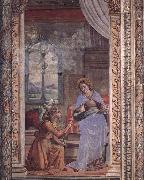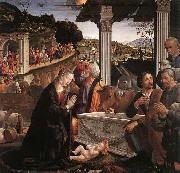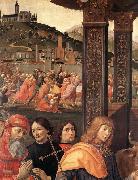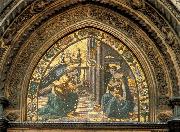All Domenico Ghirlandaio Oil PaintingsItalian 1449-1494 Domenico Ghirlandaio Galleries |
|||
 |
|||
|
|
|
||||||||||
|
|
||||||||||
|
Annunciation Måleriet Identifieringen :: 62403 |
Annunciation 1486-90 Fresco Cappella Tornabuoni, Santa Maria Novella, Florence At the height of the Presentation of the Virgin and the Marriage of Mary - above the corner of the chapel and connecting with the rear wall next to the Gothic window - there is the narrow fresco the Annunciation. Again Ghirlandaio has moved the scene of this biblical event to Tuscany and his own era. He was able to find the traditional Renaissance form of a painted window with a view of a landscape in many Florentine palaces. They can still be seen today in Florence, examples being the palaces of the Medici, Ruccelai and Strozzi families. The angel is derived from the Annunciation painted by the young Leonardo da Vinci between 1472 and 1475, now on view in the Galleria degli Uffizi. In contrast to Leonardo's horizontal format, in Ghirlandaio's fresco in the predetermined vertical format his Virgin may be depicted facing the observer in an equally frontal view, but she is standing upright. She is therefore reminiscent of the beautiful picture on the same theme by Lorenzo di Credi, an artist who was also taught by Verrocchio together with Leonardo and Ghirlandaio |
|||||||||
|
|
||||||||||
|
|
Adoration of the Shepherds Måleriet Identifieringen :: 62410 |
Adoration of the Shepherds 167 x 167 cm Santa Trinit? Florence "He painted in tempera, as a companion to this work, a Nativity of Christ which must excite the wonder of every thinking man, introducing his own portrait and some heads of shepherds, which are considered divine" (Vasari). The Sassetti Chapel is consecrated to the birth of Christ, and as a result much in the chapel is conceived with that event in mind. The altarpiece the Adoration of the Shepherds is the chapel 's key work not only in subject, but also in artistic merit. This composition was so successful that other artists frequently repeated it. Ghirlandaio himself appears in the scene, dressed as a shepherd. He is even allowed to come closer to the Christ Child than the donors, who appear in frescoes to the right and left, praying outside the confines of the panel. The artist, who is leading the shepherds, is kneeling and bringing the miracle of the birth of Christ to the attention of both the shepherds and the observers of the picture. His left hand, with which he is pointing to the Christ Child, is finely drawn and is superbly modelled in three dimensions. With his right hand, his painting hand, he is pointing to his chest, as he does in a later fresco in the Tornabuoni Chapel. As Ghirlandaio is pointing both at the child and the garlands on the Roman marble sarcophagus, it is possible that the gesture is saying: "This holy child was painted for you by me, the garland-maker Ghirlandaio." The classical sarcophagus in the picture is not just a manger for the ox and ass. It also has an iconographical significance indicated by the Latin inscription along its front: Ense cadens. Solymo. Pompei Pului[us] Augur Numen. Ait. Quae me conteg[it] Urna Dabit. [While Fulvi(us), augur of Pompey, was falling by the sword in Jerusalem he said: the urn that covers (conceals) me shall bring forth a god]. This is an ancient prophecy by Fulvius. The animals' manger will serve as a crib for the Christ Child. In his Adoration of the Shepherds, Ghirlandaio combines this reference to the Roman classical age with knowledge of Flemish art and turns them into an integrated whole. An historic event that took place a few years before this work was painted clearly left its mark behind on Ghirlandaio's work. An altarpiece ordered by Tommaso Portinari from Hugo van der Goes in Bruges reached Florence in May 1483. Florentine artists saw van der Goes' Adoration of the Shepherds as a shining comet showing new ways of painting. In Ghirlandaio's altarpiece, the shepherds pushing their way into the picture from the right, with their harsh, life-like features, are drawn directly from this Flemish model. Ghirlandaio's landscape in the background also displays features from north of the Alps |
||||||||
|
|
||||||||||
|
|
Adoration of the Magi Måleriet Identifieringen :: 62412 |
Adoration of the Magi 1488 Tempera on wood Spedale degli Innocenti, Florence Ghirlandaio (second from the right) gazes out at us from this picture, more modestly than in his other self-portrait (like in the Tornabuoni Chapel or in the Sassetti Chapel). It is thought that the churchman dressed in black in front of him is the man who commissioned the panel painting, Francesco di Giovanni Tesori. Above these two portraits, the Slaughter of the Innocents in Bethlehem is shown. The town beyond this, in which we can see monuments such as the Colosseum, Trajan's Column, the Torre del Milizie, and a pyramid, is meant to be reminiscent of Rome |
||||||||
|
|
||||||||||
|
|
Annunciation Måleriet Identifieringen :: 62999 |
Annunciation 1489-90 Mosaic Porta della Mandorla, Duomo, Florence In addition to the fresco in the Tornabuoni Chapel, Ghirlandaio created another Annunciation between 1489 and 1490 using the ancient mosaic technique, which he had learnt from Alessio Baldovinetti and which he had been able to employ when restoring a few old mosaics. There is no lectern in this mosaic version of the Annunciation, though the influence of Leonardo's painting is still felt, particularly in the spatial arrangement - a building on the left behind Mary and a view over a wall to a landscape. Above the Porta della Mandorla on Florence Cathedral there still exists this mosaic. Vasari wrote the following comment on it: "Domenico enriched the modern art of working in mosaic infinitely more than any other Tuscan, as his works, though few, amply demonstrate...". Of this mosaic destined for the Porta della Mandorla Domenico only executed the cartoon, which was probably translated into mosaic by his brother David. Artist: GHIRLANDAIO, Domenico Painting Title: Annunciation , 1451-1500 Painting Style: Italian , , religious |
||||||||
|
|
||||||||||
| FÖREGÅENDE KONSTNÄR Nästa Konstnär | ||||||||||
|
|
||||||||||
| Domenico Ghirlandaio | ||||||||||
| Italian 1449-1494 Domenico Ghirlandaio Galleries | ||||||||||
|
|
||||||||||
|
KOMMA I KONTAKT MED Oss |









